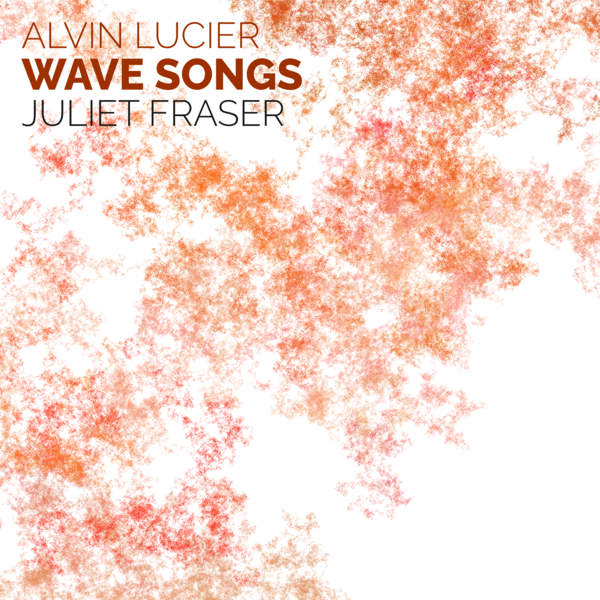
Alvin Lucier
Wave Songs
Juliet Fraser
atd19
binaural download only

The potential for disorientation is enormous, as the sensation of the air throbbing (whether in the room or in the ear) overwhelms the sense of stable pitch. The microtonal tuning here is no melodic affect but, rather, an exercise in a scientific phenomenon. Through the course of Wave Songs the pitches of the sine tones move ever closer together, seemingly hemming the singer in until she changes the rules of the game.
Critical acclaim
Expanding and exploding customary practices of listening, Lucier treats sound as material, vibration, solid yet evanescent, something both literally and metaphorically felt, a world of sonic illusion in which the distances between sine waves and the vocal line create ‘beating’ effects—as Lucier puts it, “bumps of sound produced as sound waves collide”. But this vocabulary of expansion, explosion, collapse and collision doesn’t really capture the still spirit of the piece, its moving stasis, its static movement.
As with much of Lucier’s work, the musical interest comes from the discrepancies between scientific perfection and human intervention, with no need to exaggerate the degree of their deviation. Fraser sings in a way which mixes precision with a softer edge that makes each song pulsate and shimmer.
Tracks
| Wave Songs | ||
| 1 | I | 1:50 |
| 2 | II | 1:37 |
| 3 | III | 1:42 |
| 4 | IV | 1:42 |
| 5 | V | 1:46 |
| 6 | VI | 1:47 |
| 7 | VII | 1:46 |
| 8 | VIII | 1:37 |
| 9 | IX | 1:44 |
| 10 | X | 1:47 |
| 11 | XI | 1:49 |
| TT | 19:08 |
Liner notes
The eleven canvases of Lee Lozano’s ‘Wave’ series (1967-70) paint wavelengths of light multiplying exponentially. Recognised at the time as a major statement, her series was described by art historian David Reed as ‘one of the three great series of American painting’, placed alongside Barnett Newman’s ‘Stations of the Cross’ (1958) and Andy Warhol’s ‘Shadow’ paintings (1977-8). Calmly, cosmically, they ask artist and viewer to reposition themself in space and time.
Wave Songs was commissioned from composer Alvin Lucier by the Matrix Gallery at the Wadsworth Atheneum, Hartford, Connecticut and first performed there by Joan La Barbara on 29 March 1998. Lucier draws on Lozano’s series in various ways: eleven canvases become eleven songs; visual wavelengths become sonic frequencies produced by two pure wave oscillators and disrupted by a female voice.
As Lucier explains, the difference between the oscillators’ pitches creates ‘audible beats — bumps of sound produced as the sound waves collide. The farther apart, the faster the beating. At unisons, no beating occurs.’ The oscillators alone, therefore, set up a steady rhythmic beating. The singer stands between two speakers (from which sine tones emanate) and follows a rigorous score that indicates the precise microtonal pitch in hertz of each sine tone and whether it comes from left or right, and the frequency of the additional beating she is to create with her sung pitch. The potential for disorientation is enormous, as the sensation of the air throbbing (whether in the room or in the ear) overwhelms the sense of stable pitch. The microtonal tuning here is no melodic affect but, rather, an exercise in a scientific phenomenon. Through the course of Wave Songs the pitches of the sine tones move ever closer together, seemingly hemming the singer in until she changes the rules of the game.
Song X sets a short text by Lozano, chanted by the singer on a single pitch. The words explain that ‘the waves were really a reference to the electromagnetic spectrum’ and that she was ‘trying to combine science and art and existence’ by transforming ‘a science idea’ into ‘an art idea’. Lucier’s piece is an experiment too, in converting waveforms into a musical event, and sometimes the science idea doesn’t quite translate into an art idea: sometimes the limitations of the human voice to behave with the lifeless, flat consistency of a sine tone become clear as the beating just doesn’t manifest as expected; sometimes the body betrays the brain. But as Juliet Fraser observes, Wave Songs is ultimately a piece about feeling — about the performer and the listener sensing the vibrations in the air and feeling the delicate interaction between pure waves and a human body. As such it is reminiscent of a note Lozano wrote in 1971: ‘I will be human first, artist second’.
Laura Tunbridge